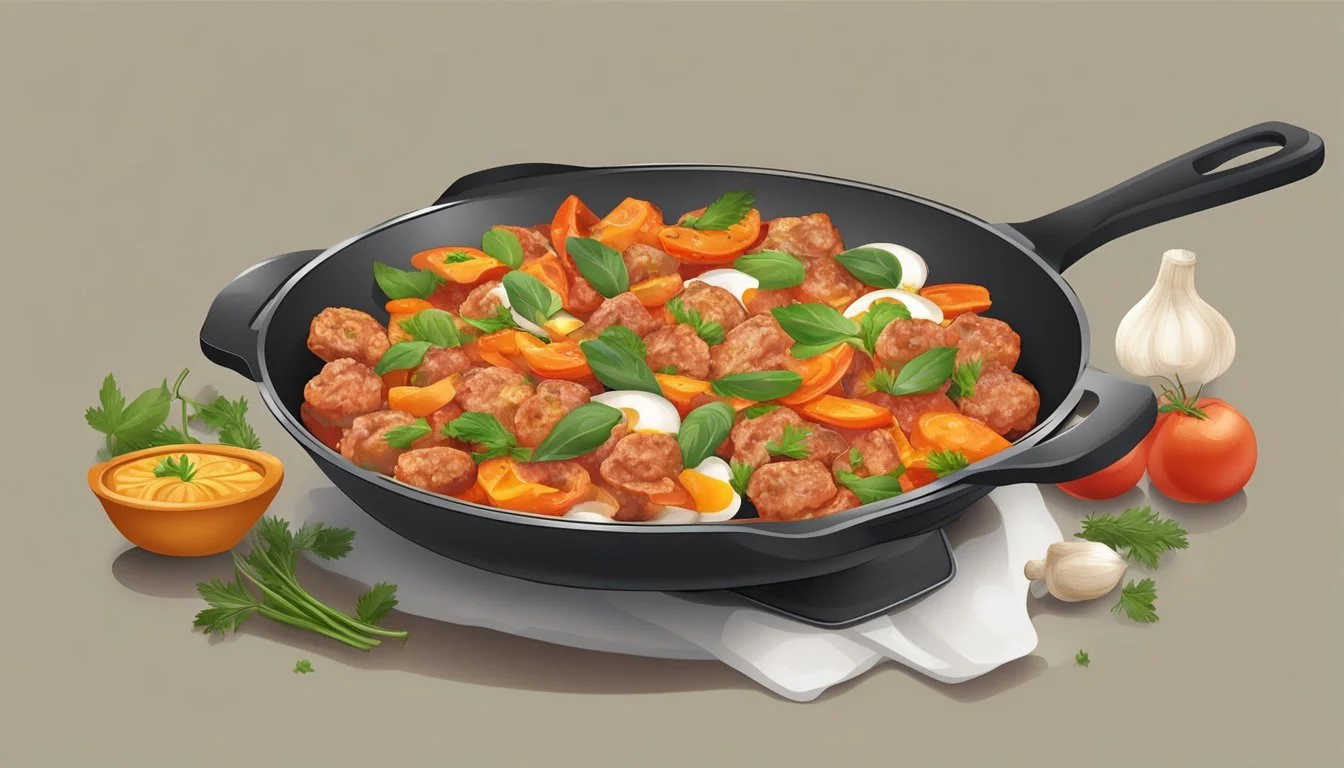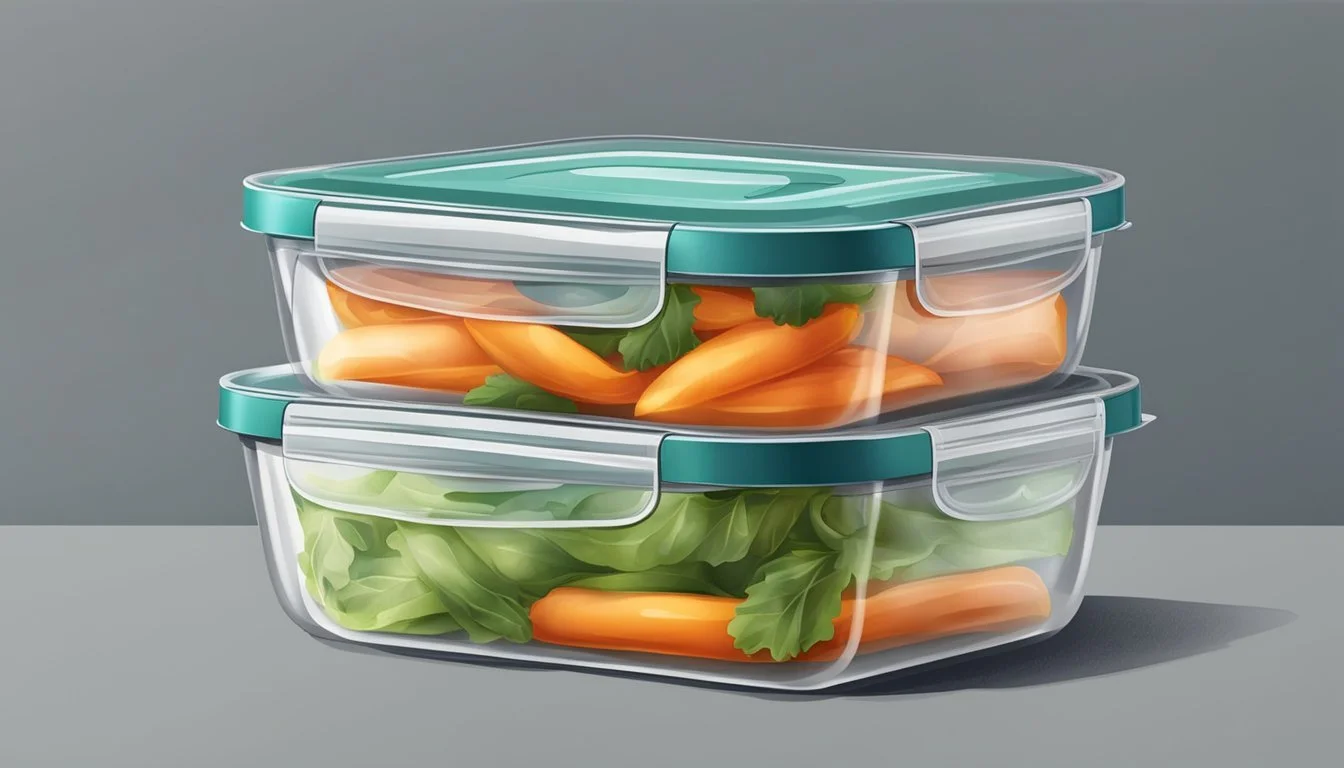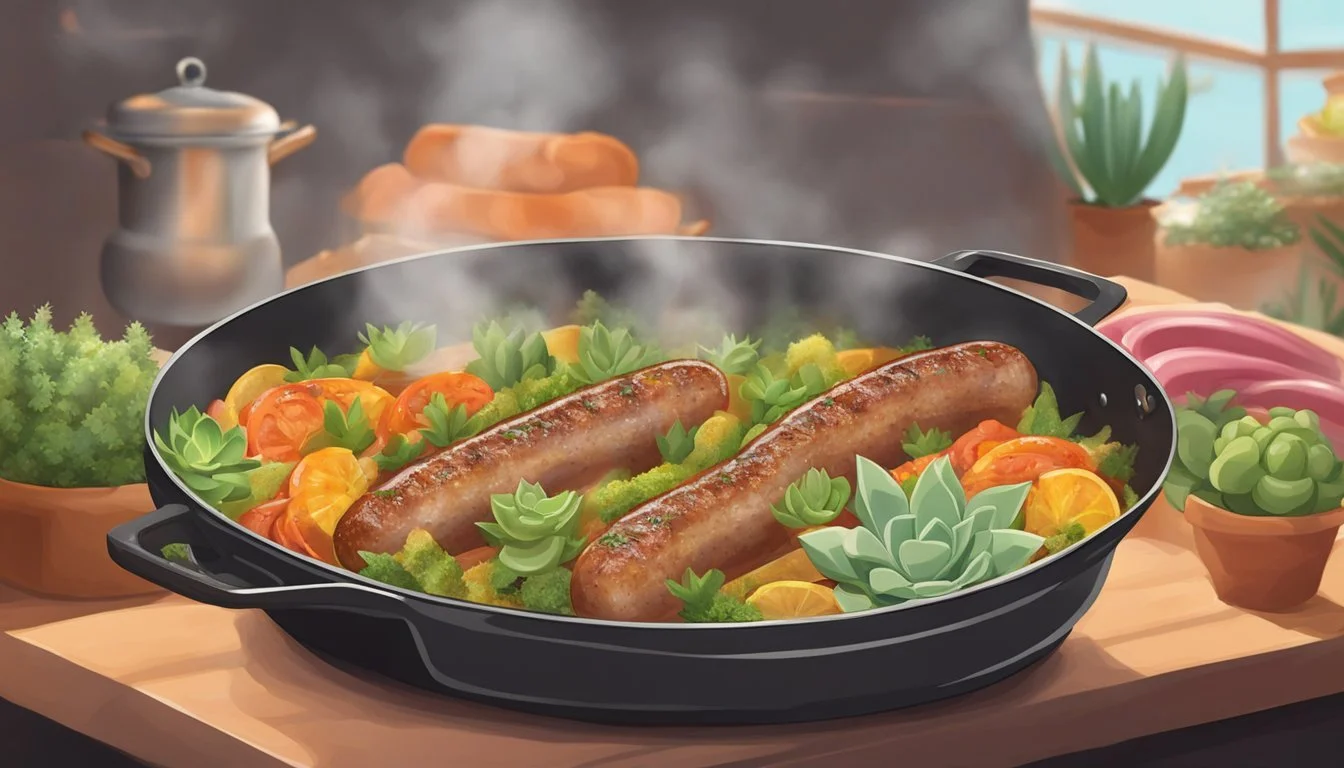Best Way to Reheat Sucuk
Preserving the Garlicky Goodness
Sucuk, a garlicky Turkish sausage, is a flavorful delicacy enjoyed for its unique blend of spices and its satisfyingly crispy texture when cooked properly. When it comes to reheating leftover sucuk, the challenge lies in preserving its robust flavor profile, particularly the signature garlicky punch, while also maintaining the outer crispiness and tender, juicy interior that is much loved.
The method used for reheating sucuk is critical, as improper warming techniques can lead to a rubbery or dry sausage that lacks the original lusciousness. To savor the delicious blend of spices and garlic, the reheating process must be carefully managed. The goal is to achieve a soft yet crispy exterior without compromising the intense flavor that sucuk is renowned for.
Reheating sucuk calls for a balance of heat and time to ensure that the sausage remains as appealing as when it was first cooked. Whether using the oven, stovetop, or a microwave, one should use a gentle heat to prevent the loss of moisture that keeps the inside soft. This prevents the overcooking of spices like garlic that can otherwise become bitter under excessive heat. By thoughtfully warming leftover sucuk, one can relish in its vibrant flavor and texture once more.
Understanding Sucuk and Its Flavor Profile
Sucuk is a distinctive semi-dried sausage, celebrated for its rich and multifaceted flavor profile. It hails from Turkish cuisine, imbued with a blend of spices that creates a taste sensation reflective of the region's culinary heritage. Central to its flavor is garlic, which imparts a pungent and somewhat sweet characteristic, integral to the traditional sucuk taste.
This sausage typically combines a mixture of ground beef with an array of spices such as black pepper, cumin, and sometimes sumac. These spices contribute to sucuk's intense flavor, adding both smoky and aromatic notes. The flavors intermingle with the garlicky base to produce a sharp, yet complex palette.
One might describe the spice blend in sucuk as subtle, despite the individual strong flavors. The curing process instills a depth of taste, as the spices infuse the meat over several weeks. This maturation period not only develops the rich flavor but also contributes to its coveted smoky undertones.
In summary, those who appreciate sucuk revel in its:
Bold Flavors: A symphony of garlic and spices for a full-bodied experience.
Aromatic Qualities: Delivers a sweet yet sharp fragrance.
Spicy Edge: Varies from subtly spicy to notably intense.
This understanding of the sausage's character is paramount when considering the best way to reheat sucuk, as the method should preserve the carefully cultivated balance of flavors.
Preparing for Reheating
Reheating sucuk properly is crucial for maintaining its signature garlicky flavor and appealing texture. This section guides you through the necessary steps, ensuring that you have everything you need for a successful result.
Gathering Necessary Ingredients and Tools
Before you begin, assemble the following materials:
Sucuk (room temperature is best to ensure even reheating)
Oil or butter (for the pan or coating)
Aluminum foil or parchment paper (for oven method)
Herbs and seasonings, such as garlic powder (to enhance flavor)
Cookware: oven tray, microwave-safe dish, air fryer basket, or stovetop pan
Be sure your workspace is properly laid out with these items for an efficient reheating process.
Food Safety Considerations
Food safety is paramount when reheating leftovers. Your sucuk should have been stored in the refrigerator if not consumed immediately and brought to room temperature safely before reheating. The internal temperature should reach 165°F (74°C) to be considered safe for consumption.
Initial Steps Before Reheating
Preparation is key: remove sucuk from the refrigerator, discard any packaging from store-bought varieties, and let it rest until it reaches room temperature, which typically takes about 15-20 minutes. This step contributes to uniform heating and preserves the texture.
Selecting the Correct Reheating Temperature
For optimal results, preheat your oven, microwave, air fryer, or stovetop to a moderate reheating temperature. Too high of a temperature can overcook the sucuk, while too low won't properly warm it through. 325°F (163°C) is generally a safe bet for ovens and air fryers.
Reheating Methods Overview
Consider your available appliances and choose accordingly:
Oven: Best for a uniform reheat
Microwave: Quick, but may lead to uneven heating
Air Fryer: Good for a crispy exterior
Stovetop: Ideal for a quick sear and flavor infusion
Toaster Oven: An efficient alternative to a full-size oven
Broiler: For a faster crisp
Slow Cooker: Not typically recommended for sucuk
Maintaining Moisture and Flavor
To prevent drying out, lightly coat the sucuk with oil or butter. For ovens and toaster ovens, wrap the sucuk in foil or parchment paper, adding a splash of water to create steam. The key is to preserve the moisture without making the sucuk soggy.
Ensuring an Even Reheat
Turn the sucuk halfway through the cooking time to ensure even reheating, regardless of the chosen method. In microwaves, utilize a lower power setting and rotate the dish if necessary to avoid hot spots.
Garnishes and Final Touches
Once properly reheated, add fresh garnishes like chopped herbs, a sprinkle of cheese for extra flavor, or pair it with complementary sides such as garlic bread or sauce. These final touches enhance the eating experience and can be added in the last couple of minutes of cooking time or after reheating.
Reheating Sucuk in the Oven
Reheating sucuk in the oven can preserve its garlicky flavor and ensure a balance between a crispy exterior and a soft interior.
Oven Reheating Benefits
Using the oven to reheat sucuk is beneficial as it evenly distributes heat, reducing the risk of overcooking while maintaining the sausage's desired texture. The consistent oven temperature allows for thorough heating, which is key to reviving the sucuk's inherent flavors and achieving a medium level of crispness on the surface.
Step-by-Step Guide to Oven Reheating
Preheat the oven to a medium temperature, typically around 350 degrees Fahrenheit, to prepare for the sucuk.
Place the slices of sucuk on a baking sheet lined with parchment paper or lightly greased aluminum foil to prevent sticking.
Cook Time: Heat the sucuk for about 10 to 15 minutes, depending on thickness. Monitor the sucuk to ensure it achieves a crispy texture without becoming too hard.
Tips for Preventing Overcooking
Temperature: Maintain the oven at a medium level; excessive heat may cause the sucuk to lose its moisture and become overly crisp.
Monitoring: Keep a close eye on the sucuk as it reheats, since different ovens may affect the cook time.
Wrapping the sucuk in aluminum foil can protect it from direct heat and preserve its juices, making the texture soft on the inside and crispy on the outside.
Reheating Sucuk on the Stovetop
Reheating sucuk on the stovetop is a method preferred for restoring its distinctive garlicky flavor while maintaining a pleasing texture. This method allows for precise temperature control, ensuring the sausage regains its appealing crispiness without being overcooked.
Advantages of Stovetop Reheating
Flavor Preservation: The stovetop reheating process helps in retaining the robust flavors of sucuk, ensuring that the garlic notes and spices are as prominent as when first cooked.
Texture Management: Using a skillet allows the sucuk to achieve a crispy outer texture while remaining juicy inside.
Stovetop Reheating Method
To reheat sucuk effectively:
Place a skillet on the stove.
Add a small amount of oil to prevent sticking and enhance crispiness.
Once the oil is heated, add the sucuk slices to the skillet.
For even reheating, cook the slices for about 1-2 minutes on each side or until they reach the desired level of crispiness.
Controlling the Heat
Medium Temperature: A medium heat setting is ideal as it reheats sucuk thoroughly without burning it.
Cook Time: The cooking time should be monitored closely; sucuk generally requires a few minutes per side to warm up and regain texture.
Frequent Checks: It's crucial to check the sucuk regularly, turning the slices to ensure even reheating and preventing any part from becoming too crispy or overdone.
Employing the stovetop method with care helps ensure that the sucuk's flavor and texture are optimally restored.
Reheating Sucuk in the Microwave
When reheating sucuk in the microwave, one should aim to preserve its moist texture and garlicky flavor while ensuring a quick reheating process. Specific techniques can help achieve this without overcooking or drying out the sausage.
How to Use the Microwave Effectively
To use the microwave effectively for reheating sucuk, one must adjust the power settings correctly. It is advisable to set the microwave's power level to 50% to avoid overheating and to maintain the texture and moisture of the sausage. A lower heat setting also prevents the risk of the sucuk becoming too tough or rubbery.
Power Level: Set microwave to 50%
Cook Time: Short intervals, checking often
Microwave Reheating Technique
The correct technique for reheating sucuk in the microwave involves:
Placement: Arrange the sucuk slices on a microwave-safe plate in a single layer to ensure even heating.
Covering: Lightly cover the plate with a microwave-safe lid or paper towel to retain moisture.
Timing: Heat in short bursts, usually 30 seconds to 1 minute, then check if additional time is needed.
Do Not use aluminum foil in the microwave as it can cause sparks.
Avoiding Common Microwave Mistakes
To avoid common microwave mistakes, one should never overcook the sucuk which can result in loss of flavor and an undesired chewy texture. It is also important to keep leftover sucuk moist during reheating by covering it properly. Overlooking these points can lead to a poor reheating experience and suboptimal results.
Overcooking: Check frequently to prevent
Moisture Loss: Cover to retain moistness
Even Heating: Rotate or stir if necessary
Reheating Sucuk in an Air Fryer
Reheating sucuk in an air fryer can maintain its appetising garlicky flavor while ensuring a crispy texture. This method is efficient and effective for restoring sucuk to its freshly cooked state.
Benefits of Air Fryer Reheating
Air fryers excel at reheating foods while preserving their texture and flavor. They circulate hot air around the food, which results in a crispy exterior without compromising the succulent interior. Reheating sucuk in an air fryer ensures that it retains its distinctive garlic taste and does not become dried out or tough.
Air Fryer Reheating Instructions
To reheat sucuk in an air fryer, it should be sliced if not already and laid out in the air fryer basket in a single layer to allow for even circulation of hot air. The air fryer should be preheated to achieve the best results, which contributes to a quicker reheating process while avoiding overcooking.
Optimal Air Fryer Settings
Preheat: Ensure that the air fryer is preheated to the optimal temperature before placing the sucuk inside.
Temperature: Set the air fryer to a medium heat, around 350°F (175°C), which is hot enough to reheat without burning the sucuk.
Cook Time: Generally, the cook time should be between 3-5 minutes. The exact time will vary based on the thickness of the sucuk slices.
By adhering to these specific guidelines, reheating sucuk in an air fryer will produce a deliciously warm and crispy result, perfectly capturing the essence of its initial serving.
Alternative Reheating Options
When seeking to maintain the succulent, garlicky flavor of sucuk while reheating, it's imperative to consider alternative methods that preserve its desirable texture and taste. These reheating strategies aim to deliver a balance between a crispy exterior and a soft, well-heated interior.
Reheating Sucuk Using a Toaster Oven
Using a toaster oven can be a quick and efficient method to reheat sucuk, especially for achieving a crispy texture.
Preheat the toaster oven to 350°F.
Arrange the sucuk slices in a single layer on the toaster oven tray.
Heat for about 2 to 4 minutes or until the desired crispiness is achieved.
A toaster oven reheats uniformly and is suitable when time is of the essence.
Slow Cooker Reheating Method
For those preferring to retain maximum moisture and obtain a soft texture, using a slow cooker is an ideal option.
Place the sucuk in the slow cooker.
Set the cooker on low and allow the sucuk to gently warm up for approximately 30 minutes.
This slow process helps the sucuk to heat evenly without sacrificing its garlicky flavor.
Broiler Reheating Option
A broiler offers a quick reheating solution that can imbue the sucuk with a pleasantly crispy exterior.
Preheat the broiler.
Place sucuk slices on a broiler-safe pan.
Broil for 1 to 2 minutes on each side, monitoring closely to avoid burning.
The broiler excels in recreating a texture similar to that achieved during initial cooking, lending a crispiness to the edges quickly.
Pairing and Serving
Once the sucuk is skillfully reheated to maintain its robust garlicky flavor, one must consider the best ways to serve it to complement its unique taste and texture.
Serving Suggestions for Reheated Sucuk
Reheated sucuk is excellent when served hot as it brings out its distinctive spices and garlicky aroma. It can be sliced thinly and added to a variety of family recipes to enhance their flavor. It is commonly incorporated into traditional breakfast dishes or served alongside eggs. For a simple yet delicious approach, one can also place slices on garlic bread, creating a rich and savory snack.
Combining Flavors and Textures
The bold flavor of sucuk pairs well with milder ingredients that do not overshadow its taste. Cheese, with its creamy texture and subtle taste, forms a harmonious combination with the spiciness of the sucuk. Cheddar or mozzarella can be melted over the top for a gooey and spicy treat. The key is to balance the spicy and garlicky flavor of the sucuk with fresh, creamy, or acidic components to create a well-rounded dish.
Accompaniments and Side Dishes
Side Dish Description Salad A crisp green salad with a tangy vinaigrette complements the rich, spicy sucuk by providing a fresh contrast. Sauces Light sauces, such as tzatziki or a mild tomato sauce, can cool the palate and elevate the garlicky notes. Herbs Fresh herbs such as parsley or cilantro can add brightness and help balance the dish's flavor profile.
When serving sucuk as part of a larger meal, one should select side dishes and accompaniments that bring out its flavors without competing with them for the spotlight. A side of garlic bread makes a superb carrier for the meat, while a selection of fresh herbs in a salad or as a garnish can provide a refreshing counterbalance to the meat's intense seasoning.
Storing and Keeping Sucuk Fresh
To maintain the rich garlic flavor and freshness of sucuk, proper storage methods must be meticulously followed. Whether dealing with leftover or store-bought sausage, these practices ensure sucuk retains its quality.
Best Practices for Storing Leftovers
Leftover sucuk should be stored in an airtight container or tightly wrapped in cling film and placed in the refrigerator as soon as it cools down to room temperature. This method prevents moisture loss and keeps the garlic flavor intact. The refrigerator should be set at a consistent temperature to keep the sucuk fresh.
Cold Storage (Refrigerator):
Temperature: Below 40°F (4°C)
Container: Airtight container or cling film
Shelf Life: Up to 3-4 days
Freezing and Thawing Guidelines
For long-term preservation, sucuk can be stored in the freezer. Freezing not only extends the shelf life but also retains the moisture and robust flavors of the sausage. Wrap the sucuk tightly in freezer-safe wrap or vacuum-seal to prevent freezer burn.
Thawing should be done gradually by transferring the frozen sucuk to the refrigerator, allowing it to thaw slowly and surely. Rapid temperature changes can affect the sausage's texture and flavor.
Safe Freezing:
Wrap: Freezer-safe wrap or vacuum-sealing
Temperature: 0°F (-18°C) or lower
Shelf Life: Up to 2-3 months
Maximizing Freshness and Quality
To maximize the freshness and quality of sucuk, whether it's leftover or fresh from the store, always ensure it's stored away from strong-smelling foods, as it can absorb odors. When reheating, bring the sucuk to room temperature for a few minutes to ensure even heating and retention of the garlicky essence. Avoid excessive reheating, as this can dry out the sausage and diminish the flavor.
Tips for Quality:
Store separately from strong-smelling items
Bring to room temperature before reheating
Do not reheat multiple times
Conclusion
Reheating sucuk properly is crucial for preserving its robust garlicky flavor and desirable texture. To ensure the sucuk remains delicious, one should avoid overheating, which can cause the meat to become tough and lose its essential qualities.
Oven Reheating: Warming sucuk in a preheated oven at a moderate temperature enables even heating and maintenance of succulence.
Pan Frying: Gently reheating in a skillet helps to retain the flavorful juices and create a slightly crispy exterior.
Microwave: Although convenient, be cautious as this method can unevenly heat the sucuk and affect its texture.
To enjoy sucuk in various recipes, whether in sandwiches, as part of a hearty breakfast, or as a savory addition to traditional dishes, paying attention to the reheating process is key. Using the right technique, cooks can serve up this garlic-infused meat with confidence that its unique taste and quality will be intact. Remember, patience and gentle heating are the allies of flavor and texture in the kitchen.
Frequently Asked Questions
In addressing common concerns, this section provides insight into reheating sucuk without compromising its garlicky essence, emphasizes the significance of garlic for sucuk's flavor profile, and suggests ways to revitalize leftover sucuk in new dishes.
Dealing With Common Reheating Challenges
Reheating sucuk requires a careful balance to prevent altering its medium texture and robust garlic flavor. When reheated improperly, sucuk can become overly tough or lose its aromatic qualities. It's vital to avoid overcooking. The suggested method is a gentle reheating process, either in a pan over medium heat or in the oven. One must watch carefully and turn the sucuk frequently to ensure even warming without drying it out.
The Role of Garlic in Sucuk Flavor
Garlic is not just an ingredient in sucuk; it's the cornerstone that imparts the characteristic garlicky flavor. Freshly minced garlic or whole cloves are often used in the making of sucuk, leading to a pronounced and aromatic taste. When reheating sucuk, one should strive to retain this essential garlic flavor by not subjecting it to high heat, which can diminish its bold aromatic presence.
Incorporating Leftover Sucuk Into Recipes
Leftover sucuk is a flavorful addition to various recipes, from omelets to stews. To maintain its texture and aroma when adding to dishes:
Dice or slice the leftover sucuk to spread its garlic flavor evenly.
Introduce it towards the end of cooking to avoid overcooking while still allowing it to infuse into the other ingredients.
Utilize sucuk in recipes that benefit from a punch of umami and richness.
Using leftover sucuk can be a creative endeavor, enhancing the taste profiles of both classic and innovative dishes.











